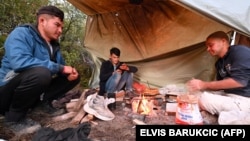Gazing across the green waters of the Drina, it appears as if you could step over the river without getting your shirt wet.
Appearances can be deceptive, however. After a boat carrying migrants capsized during the night of August 21-22, 11 people have been reported dead attempting to cross the river from Serbia to Bosnia-Herzegovina.
Ivica Dacic, the interior minister of Serbia, announced on August 22 that rescuers had found 18 people alive, including three children, who had made it to the riverbank. The tragedy occurred near the village of Tegara in eastern Bosnia.
Many others have suffered a similar fate. Around 60 migrants, many whose names, nationalities, and religions remain unknown, have been buried in cemeteries on the Bosnian side of the river. It's likely the perilous waters have claimed even more lives than reported.
According to official data from the UN's International Organization for Migration, in 2023, 45 people -- often fleeing poverty and war -- died on the long and arduous journey from Africa and Asia through the Balkans to Western Europe.
The so-called Balkan route came to prominence in 2015, when more than 760,000 migrants and refugees passed through the western Balkans on their way to the European Union. Most of those refugees came from war-torn Syria, according to official data from the European border and coast guard agency, Frontex.
Typically, desperate migrants travel by sea or land from Turkey to Greece, and then make their way through North Macedonia and Serbia, before trying to enter the European Union through Hungary, Croatia, or Slovenia. Others go through Bulgaria instead of Greece.
An official from Bosnia's Security Ministry, which enforces the country's immigration and asylum policies, told RFE/RL's Balkan Service that migrants traveling along the Balkan route have two main options. (The official was speaking on the condition of anonymity, as he is not authorized to speak to the media.)
Paying Traffickers
One option was to pay human traffickers in Turkey between 100 euros ($112) and 400 euros ($448) to receive specific GPS coordinates for routes to Bulgaria. According to the official, they then paid a similar amount in Bulgaria for coordinates leading to Serbia, and then again in Serbia for a route to Bosnia. The process continues until they reach EU member Croatia.
The second option, according to the Bosnian official, is for migrants to pay around 10,000 euros ($11,195) for a more comprehensive service. This includes an escort provided by human traffickers who take them to each border before handing them over to a new guide on the other side. Local drivers frequently transport them on small, rural roads.
For people smugglers, Bosnia is a preferred route due to its relatively porous borders and a shortage of border guards. In 2023, 162 people were charged with human trafficking in Bosnia. Most of the accused are Bosnian, as well as some citizens of Germany, Spain, and Turkey.
In the future, Bosnia's borders could become even more porous, as nearly a third of the approximately 1,800 border police officers in the country are set to retire within the next three years.
Although the EU has offered help, officers from the European border and coast guard agency Frontex have not been deployed to Bosnia, partly due to the constant political disagreements in the ethnically divided state.
The numbers of migrants traveling along the Balkan route have substantially decreased from their peak in 2015, largely due to tightened border security, changes in migration trends, and better cooperation between EU and non-EU countries.
According to data from the Serbian Commissariat for Refugees and Migration, more than 107,000 migrants passed through Serbia in 2023. Their average length of stay in Serbia was 12 days, according to the commissariat.
In 2023, the Bosnian Security Ministry recorded around 34,400 migrants passing through the country. And so far this year, 16,778 migrants were registered up to August 18. Among them, there were around 14,400 Afghans, 7,100 Moroccans, 2,500 Syrians, and around 1,000 people each from Pakistan, Turkey, Bangladesh, and Iran.
Few stay in Bosnia for extended periods of time, with the migrants preferring to make their way to the EU, where work opportunities are thought to be better. Migrants predominantly cross borders during the warmer months, with many spending the winter in four reception centers across Bosnia, which offer around 4,000 beds.
Official data from Bosnia indicates that less than 1 percent of migrants apply for asylum, with an average of about 150 applications per year. Of those applications, only around 10 percent are approved.
In addition to the risks posed by the environment and terrain, border patrol officers and police frequently beat and pursue migrants across the Balkans. On Bosnia's border with Croatia, many migrants have alleged that Croatian police have beaten them and confiscated their money, mobile phones, and other belongings -- claims the Croatian authorities reject.
